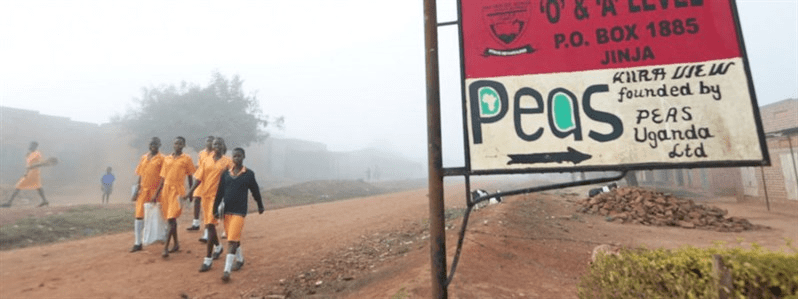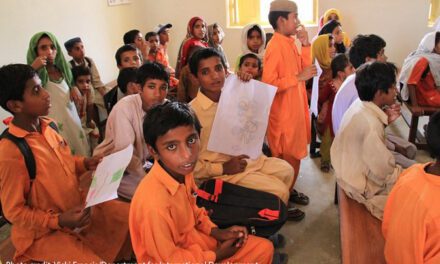This is a blog written by Libby Hills, Head of Education at PEAS. At the recent ‘Voices of the next generation: Shaping the future of education in development’ conference in London on 1st June 2017, Libby co-delivered a session on PPPs with James O’Donoghue from Ark’s Education Partnership Group. Ark’s Education Partnerships Group supports governments with developing education PPPs, and is advising the Liberian Government on the implementation of an ambitious new PPP programme. In their session, PEAS and Ark drew on their experiences and lessons learned from Liberia and Uganda to develop a ‘healthy PPP’ framework with participants.
The potential of public-private partnerships (PPPs) to improve access to and quality of education while supporting system strengthening: PEAS’ Uganda PPP experience
Education public-private partnerships (PPPs), where the public sector finances and regulates education and the private sector (non-profit and for-profit) delivers education, are gaining momentum in the developing world. The Pearson Affordable Learning Fund identified school management PPPs as a macro policy trend for 2017 and partnership with non-state actors has been recognised as a key mechanism for financing education access by the Education Commission for Financing Global Education Opportunity.
PPPs are not without controversy. Some PPP criticisms that we frequently encounter at PEAS include concerns that private sector involvement in education delivery could entrench inequality, and that many developing country governments currently have insufficient capacity to effectively regulate private schools to ensure quality. In return, champions highlight the ability of PPPs to stimulate investment from the private sector and point to the potential cost-savings for government and families. The debate is highly polarised and complicated by the lack of conclusive evidence. As one of the few non-state education providers with experience of working in a PPP arrangement in sub-Saharan Africa, PEAS is well-placed to contribute to the PPP debate.
PEAS has been participating in the Uganda Universal Secondary Education (USE) PPP programme since 2011. Under the Uganda PPP framework, schools receive a per-student subsidy from the Government to cover school running costs. There is promising RCT evidence to suggest that the Uganda PPP programme met its main objective of improving access to secondary education.
Equity is core to PEAS’ mission so we use USE PPP funding to keep school fees as low as possible. While any school fee represents a barrier for the very poorest students, our external evaluation data shows that our schools are serving disadvantaged students who largely would not access school otherwise. Our schools admit twice as many of the poorest students as do government schools, and three times as many as do other private schools.
USE PPP funding is a guaranteed, continuous revenue stream. It is more sustainable and predictable than grant funding. PPP funding has helped us secure philanthropic funding for school infrastructure in Uganda because donors are more willing to fund capital costs if they know that the model can then run on its own with little additional support – unlike other less sustainable approaches.
However the PPP programme in Uganda is not without its challenges. We want to reduce our already low school fees to zero, but the level of PPP funding is not currently high enough for us to do so without having to make difficult trade-offs. The uncertain future of the PPP policy is another challenging area for us as a non-state partner. The Government of Uganda is interested in improving the PPP framework and, while we would certainly encourage evidence-based reform of the programme, it is difficult for us to invest in further network expansion while the future of the policy is unclear.
Our experience in Uganda has shown us how important taking a system-wide perspective is when considering the potential risks and benefits of PPPs. We are starting to use our experience in Uganda and other available evidence to outline what success factors we think need to be in place to ensure that PPPs contribute to a well-regulated education system, which can provide high quality education for all students – what we are starting to describe as a ‘healthy’ PPP. As part of this effort, we have developed three emerging principles to explain how we think non-state operators can contribute to healthy PPPs –
- Operators can support system strengthening by being transparent and collaborative
We think that it is important for non-state operators to share data, best practices and resources to strengthen the evidence base for what works regarding non-state involvement in education delivery. PEAS aims to improve education for all children, not just those in our schools. PEAS’ social mission helps drive us to be highly transparent and, as far as our resources allow, provide advice to other education providers. We have an annual failure report and share all of our external evaluation data.
- In weak regulatory environments it is important for operators to be ‘socially responsible’
Where government regulation is not yet robust, we think that operators’ internal incentives or motivations need to be aligned to positive social impact. If this is not the case, there is a risk that operators focus on delivering perceived rather than actual quality in schools to attract and retain students, or that they practice selective admissions by enrolling students who are cheaper to educate, like students with higher prior attainment, for example
It is also important that non-state operators have clear parameters for scale. In education markets, the ultimate responsibility for education provision lies with the government. In systems where regulation is weak, operators could reach a size at which they are too big to fail without substantially, negatively impacting provision. This could put governments under pressure to bail out large but poorly performing non-state operators.
Working in partnership with socially responsible operators could help governments test and develop the regulation needed to manage a more diverse range of non-state operators.
- Sufficient funding and stability of policy are important to encourage private partners
PPP funding represents a sustainable funding source which can incentivise non-state operators to start schools and grow networks of multiple schools. However, PPP funding and the policy environment both need to be stable to stimulate investment.
Based on our experience in Uganda, and other available evidence, we think that well-designed and well-executed PPPs have the potential to be a useful tool for governments looking to expand equity, access and quality in education. We want to continue to work with other actors – through opportunities like the early career conference – to better understand PPP ecosystems and build the evidence base for what does (or doesn’t) work when it comes to this contentious way of bringing public and private together.
Libby Hills (@libbylhhills) is Head of Education at PEAS, and is currently based in London. Libby has worked with PEAS for five years, three years of which have been spent in Zambia and Uganda. She is a Teach First ambassador and a qualified Advanced Skills Teacher.
PEAS builds and runs chains of not-for-profit low cost private schools in public-private partnership with governments. Our mission is to expand access to sustainably delivered, quality secondary education in Africa. External evaluation data shows that PEAS schools in Uganda are delivering higher quality education, to more disadvantaged students, and at lower average cost per student than government schools




Thanks for this insightful article.